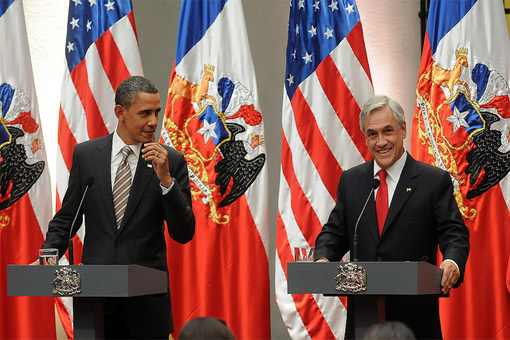Christopher Sabatini and Ryan Berger’s CNN op-ed (“Why the U.S. Can’t Afford to Ignore Latin America,” June 13, 2012), commenting on the scant attention the Center for a New American Security’s recent “grand strategy” report paid to the Americas, outlined three compelling reasons why Latin America must figure prominently in the United States’ strategic calculations.
Their case boils down to our need for regional allies; Latin America’s increasing global integration; and ongoing security challenges in the hemisphere.
These observations are spot-on; today the hemisphere represents a remarkable series of opportunities. What the authors could have gone on to say is that these understandings are today at the core of U.S. policies in the region, which have never been more grounded in our long-term interests, and the practical and sustained efforts needed to advance them. While headlines have largely focused on crises and threats elsewhere, 21st century U.S. engagement with—and partnership in—the Western Hemisphere have grown steadily. Judged in terms of its scope and effectiveness, that engagement is at an historic high point.
This signals a profound recognition, in political capitals and business centers alike, that the Americas are becoming a critical platform for our shared competitiveness, growth, and security. Our governments and businesses are embracing the huge comparative advantages our geography confers—what Secretary of State Hillary Clinton refers to as “the power of proximity.” Today, we recognize too what a strength and advantage our demographic links with the rest of the Americas are— vectors for innovation, shared values and common purpose.
In North America, economic integration has progressed to the point where production is nearly seamless, to the huge advantage of all three economies. We are making continuous strides toward greater regulatory harmonization and smarter, more efficient border infrastructure. These will directly strengthen our nations’ competitive positions in the world and accelerate growth and job creation.
The Trans-Pacific Partnership (TPP) negotiations are proceeding at a fast pace. TPP’s ambitious goal is to link together dynamic economies in the Asia-Pacific in fair, open, high quality trading relationships. TPP represents a new milestone in global trade, a 21st century agreement that can help create a vast and level playing field on which all can play and win. Mexico and Canada were just this week ushered into the TPP talks, joining the U.S., Chile, Peru, and other key Asian and Pacific states. In the Americas, Colombia, Costa Rica, and others, are all natural candidates for accession as well, and have strongly signaled their interest in participating in what could be a game-changing new process of boosting trade, growth, and prosperity. The broader Pacific—with half the world’s population—seems destined to be the most dynamic and consequential part of the world for U.S. and Latin American interests for years to come. The Americas’ growing links across the Pacific are helping define a new narrative for 21st-century integration—one that challenges old geographic nostrums and bureaucratic organization, as Deputy Secretary of State Bill Burns commented at the World Affairs Councils of America last year.
Nearly half our exports go to other countries in North America, the Caribbean, Central America, and South America. More than half our imported energy comes from the region, and that percentage is growing rapidly. New technologies in renewable and fossil fuels, recently-found energy reserves (e.g. in Canada, the U.S., Brazil, and Colombia), and deep commitment to build energy connectivity in the Americas, point clearly toward a not-so-distant future of energy self-sufficiency and security in the hemisphere. The local and geopolitical implications of this transition are enormous.
Size, of course, does matter. Generally, when people talk about China or India’s rise the word “billion” is used early and often. The Americas, together, need to be seen as another “emerging” billion—but with arguably far more favorable demographics, resource bases, governance and social consensus, human capital, and values affinities than in other parts of the world. It’s also a billion that accounts for about one-third of the world’s GDP.
Just as important, we are a hemisphere largely devoid of the toxic social and ethnic antagonisms that fuel incessant conflict and hatred—and so tragically stymie development—in many regions. This reality is all the more remarkable given the diversity of the Americas, and old traditions of exclusion that mark and mar our histories. But, if those traditions are long, so are our ongoing efforts and cooperation, in every country of the Americas, to overcome them and build more truly inclusive and democratic societies.
Today, the majority of the countries in the Americas are leveraging open and increasingly inclusive economies, and political systems, to succeed at a global level. This is confirmed not only by trade statistics but by participation and leadership in the international coalitions and organizations (e.g., the OECD, G-20, APEC) that are helping shape the important rules and standards needed to ensure a prosperous, stable and secure international order in the 21st century.
This week alone world leaders are gathering for major international conferences hosted by Mexico and Brazil, in Los Cabos (G-20) and Rio de Janeiro (Rio+20). In those and other fora, many countries in the Americas increasingly punch above their weight, and are emerging as net contributors to regional and global public goods. This fact alone is of huge strategic significance for the U.S. as we survey our resource constraints, and the competitive, challenging, and uncertain contours of the decades ahead.
We know the reality of the Americas isn’t all peaches and cream. It is difficult to chart the challenges that global, economic, and security problems may impose on the region, but they will probably be legion. Internal challenges will likely abound too as cities grow, infrastructure is strained, and institutions struggle to respond to the needs of changing societies. Several countries today are following heterodox or outdated policies that risk jeopardizing their long-term growth. Some of the same countries are implementing policies that affect their peoples’ basic liberties.
Over the past two decades, the inter-American system, with the OAS and its human rights bodies at its core, has made great strides towards ensuring more equitable protection of democracy and fundamental freedoms across the hemisphere. Those developments have been of fundamental importance to the region’s economic and social advance. As the hemisphere’s preeminent and universal organization, the OAS is an important bulwark for the protection of these vital gains, even as some also embrace various new multilateral mechanisms intended to promote integration and address regional challenges. How effectively and transparently those institutions do so, and respond to future governance and other crises, will be important tests of their credibility, buoyancy, and value to the countries of the Americas.
But, make no mistake, legitimate and effective multilateral institutions in the hemisphere will be absolutely critical to meeting the challenges—and reaching the promise—we can see on the horizon. This is especially pressing as the diffusion of political and economic power, or the complexity of many challenges, affect the ability or willingness of individual states to address many big issues decisively. Every person in the Americas has a serious stake in our success, today, building on the region’s solid multilateral foundations and institutions, in crafting a more effective architecture for concerted action. Our failure to achieve this would entail huge, possibly crippling, opportunity costs.
A lot of U.S. media coverage of the region focuses on the violence and other nefarious manifestations of drug cartels and other transnational crime syndicates. As we pursue a constructive agenda with partners to build on success in the Americas, it is critical that we also work effectively to address common threats. In this area, too, we are achieving historically unprecedented levels of real cooperation.
Colombia’s success against a decades-long narco-insurgency provides eloquent testimony to what national resolve and courage can achieve—and to how valuable international partnership can be in that process. Peering through the swirl of today’s violence in parts of Mexico, Central America, and some urban centers in South America, it is obvious that something new is happening. Nations are pooling experience and capacity as never before. Societies are learning from each other through new horizontal linkages between government agencies and civic groups. Citizens are demanding greater accountability and more effective institutions. And, we have been more straightforward than ever in facing up to our shared responsibilities in crime-driven violence.
This does not mean that the solution to drug violence will be easy, fast, or ever complete. To the contrary. However, there is clearly strong determination on the part of governments and individual citizens to resist the criminal groups that threaten individual safety and the integrity of governing institutions. It is overwhelmingly in our interest to support that determination, as we are doing through a number of partnerships focused on demand, security, economic, and institutional aspects of the problem.
Judged by the criteria of global trends in areas such as population, resources, social empowerment, and power diffusion, the Americas seem clearly to be a region of vast promise. U.S. engagement reflects the measure of that promise, and our critical interest in its fulfillment.
It is tremendously important that influential voices in the outside policy community, academia, and the private sector move decisively beyond the clichés, stereotypes, and old narratives (e.g., old mantras about neglect or interference) that still too often impede constructive discussion of Latin America and our interests there. Old-think still permeates too much treatment of the region by the Right, the Left, in the human rights community, in the security community, and among academics. This has at times been a challenge in government as well, as the region has changed profoundly over the last few decades. But, it is important that government, the private sector, and the larger policy and academic communities get ahead of this curve.
This is necessary, first and foremost, because the sustained success of the Americas is not inevitable. Even in the most optimistic scenarios, it will be uneven and there will be a lot of speed bumps. Such success will require more of the new thinking, founded on real partnership, that is animating the United States’ approach in the region. It will require harnessing the new impulses toward cooperation and integration that are evident around the hemisphere. Obviously, too, it will require, in each country, and no less in the United States, that governments be able to implement and sustain sound policies—in a suite of vital areas that includes infrastructure, education, trade, and taxation—that will provide the foundations for long-term national and hemispheric growth and progress. That task will not be easy.
So, an updated public understanding is needed—one that takes account of the rapidly changing face of the Americas and the way its countries interact with each other, the the accelerating global integration of most countries there, and our interdependence with our neighbors.
The extent to which the policy community can foster discussion that promotes and shapes that understanding will fulfill an important strategic need. Certainly, any strategy framework that omits Latin America is overlooking one of the most important dynamics in our nation’s future security, strength, and prosperity.






